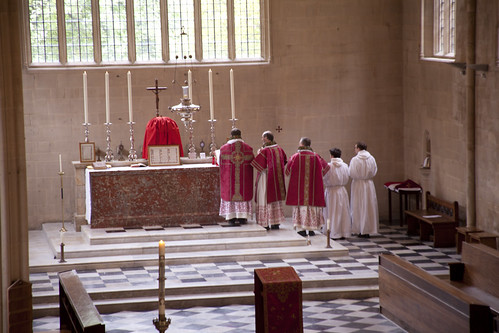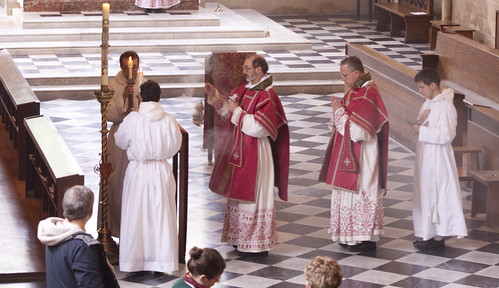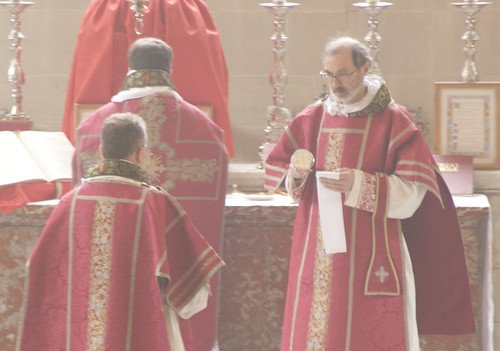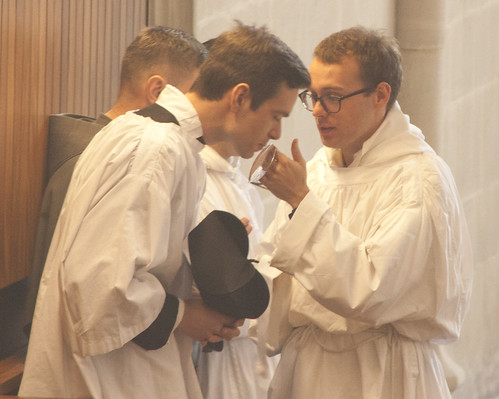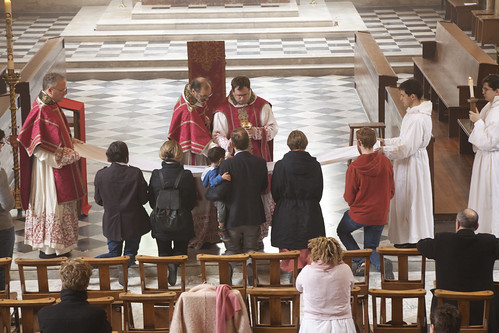Chairman's Blog
Bullying and ostracism from the Catholic Education Service
 Copies of a guidance document entitled 'Made in God's Image', on homophobic bullying, from the Catholic Education Service are doing the rounds. It is going to be sent to Catholic schools soon but Mark Lambert has put the pdf on DropBox and made a few comments.
Copies of a guidance document entitled 'Made in God's Image', on homophobic bullying, from the Catholic Education Service are doing the rounds. It is going to be sent to Catholic schools soon but Mark Lambert has put the pdf on DropBox and made a few comments.
The document has both superficial and deep problems. Superficially, I'm suspicious of documents which don't include the names of the people who drew them up, or indeed the name of anyone willing to take responsibility for it. This document has the logos of the CES, St Mary's University, and the Aquinas Centre for Theological Literacy on it. Is it actually endorsed by these institutions? (Did St Mary's ask its governing body to vote on it? I hardly think so.) Where does it come from? Who paid for it? Who composed it? No matter, the CES is promoting it, maybe that is all we need to know.
Again, this is a 37-page document on homophobic bullying, which sets out lesson plans for eight 50-minute lessons to be devoted exclusively to this topic. What about other forms of bullying? What about other forms of bullying which target 'protected characteristics' under English law? No doubt the CES has policies on all these things but there is no sense of an integrated approach here. How does this fit in with Sex Ed, Religious Studies, or anything else? It is not even clear what teachers are supposed to deliver these lessons, which make frequent reference to gospel passages, but stray into history, current affairs, and Sex Ed. In some places the reader gets the impression that it would be PE teachers who are most relevant to the issues raised.
But again, maybe that's not so important. After all, I've no doubt homophobic bullying is perfectly real, and needs to be addressed in our schools. Here is a document which aims to do that. So how does it set about it?
First, some definitions.
'Homophobic bullying is bullying that is based on prejudice or negative attitudes, beliefs or views about lesbian, gay or bi people.' (p3)
Again (p23):
Homophobia is the fear, dislike or hatred of gay people. Bullying involves excluding, humiliating or threatening people. Therefore homophobic bullying is when someone is excluded, humiliated or
threatened because they are (or people think they are) gay.
A US government website on bullying gives us a more complete definition of bullying:
'Bullying is unwanted, aggressive behaviour among school aged children that involves a real or perceived power imbalance.'
Although the document gives examples of bullying as well, it is not bullying which is the real target here. Nor, in fact, is homophobia. The child who says 'those trainers are so gay' is not, necessarily, a homophobe: such a remark does not suggest, much less prove, that he or she has a fear or dislike of gay people. As noted, this use of language is, like the use of profanities, regrettable, but what is even more regrettable is the judging and labelling of children, to be followed by their exclusion, humiliation, and threatening, on the basis of their careless use of language.
The attitude of the father in the later example is not clear, because we don't actually know if he is using the word 'gay' to denote orientation, lifestyle choice, or cultural and political advocacy. The very fact that he knows a media personality is 'gay' suggests that it is not just a matter of orientation. Celebs 'come out as gay', generally speaking, as a cultural and political gesture. However, the case is clearer in another example in the document (p26).
She sighs and says that Andrew is old enough to know now: Uncle Michael is gay and has been living with his boyfriend for the last five years. His mum is looking really upset. ‘That sort of thing isn’t right, Andrew, and I’m not having it – living with a man, for God’s sake! I wouldn’t be exposing you to that nonsense. He knows the family doesn’t approve of him and he just goes right ahead and does it anyway.’
Andrew is surprised, and even more confused. ‘So that’s why you don’t like him anymore? Just because he’s gay? Why?’
‘It’s wrong, Andrew. Now just leave it, will you?’
Here we have a clear example, and presumably it is supposed to be a clear example, of an attitude towards someone based on transgressive public behaviour. Uncle Michael has adopted a lifestyle at odds with the moral law, and Andrew's mother does not want her son to be exposed to this behaviour. This is given as an example of homophobia.
The authors of 'Made in God's Image' are playing a dangerous, if familiar, game. Fear and hatred of 'gays' is wrong, they say, and few indeed would disagree. The Church's teaching on sexuality can still be taught in Catholic schools, they say: and isn't that nice? But when it comes down to it, being influenced by that teaching just is homophobic. To distance oneself from wrongful public behaviour cannot, we are told, be separated from the idea of fearing and hating a whole category of people, on the basis that some of the people in this category might on occasion behave wrongly.
On the same argument, if Uncle Michael was a remarried divorcee having a string of affairs, then any objection by Andrew's 'mum' to going round to see him with her children would count as heterophobia. Somehow the authors of this document would deny that this conclusion follows. It doesn't make sense. It doesn't have to make sense. This is gaslighting.
The classroom discussions proposed by the 'Made in God's Image' (p22), are, for people eschewing all judgmentalism and accepting everyone as they are, extraordinarily manipulative. Having started from the assumption that homophobia is deeply bad, pupils are invited to discuss in small groups a series of possibly-homophobic scenarios. This set-up is bound to push the pupils to taking the widest possible view of homophobia. Who wants to be the one to say: 'I don't think this case is homophobic', thereby providing evidence that they are themselves homophobic? What a gift to the classroom bully, whether child or teacher, any such evidence would be.
This document is not about combating bullying. It uses the real suffering of one set of bullying victims to justify using the extremely one-sided power relations between managers and teachers, and between teachers and pupils, to indulge in a bit of bullying of its own. It claims to be against judging people, but it advocates taking a child's most careless word as evidence of moral failings. It claims to be about 'accepting' people in accordance with the teaching of the Church, but there is no acceptance of people who take seriously Catholic teaching on sexuality.
In pursuit of this agenda, the message of the Gospel is bent completely out of shape. 'Made in God's Image' tells us (p.18) that Jesus refused to judge people and told us not to judge anyone. Nowhere can it be admitted that Jesus condemned the lake-side towns, Jerusalem, or the Pharisees, for their failings; that he said 'For the Father judgeth no man, but hath committed all judgment unto the Son' (John 5:22), nor yet that that he passed on this right and duty to judge to the Apostles, who would 'sit on thrones and judge the twelve tribes of Israel' (Luke 22:30); nor, indeed, that he said that sexual sins 'defile a man' (Mat 15:19), and exclude people from heaven.
The characterisation of the Pharisees themselves is grossly historically biased, and the references to ancient and modern Jewish practice (p17) could be construed as anti-semitic.
Nor can it be admitted clearly that Christ's reaction to the 'sinner' who washed his feet with her tears was connected with her repentance of her sins. Instead, the children are invited 'meditate' on a version of the story in which this inconvenient word is not used, using techniques familiar to practioners of yoga and hypnosis (p19):
Close your eyes, relax your shoulders, take a moment to notice sounds around you and let them go. Breathe out any tension in your body and when you are ready, allow yourself to gently enter the scene from the story, ...
I think Catholic parents at this point are entitled to ask the Catholic educational establishment: who gave you the right to manipulate my children and turn them against the moral guidance of their parents?
Support the work of the LMS by becoming an 'Anniversary Supporter'.
Dominican High Mass for St Peter Martyr: photos
Last Saturday Oxford's Dominicans celebrated a High Mass; it was the feast of St Peter Martyr in the Dominican calendar.
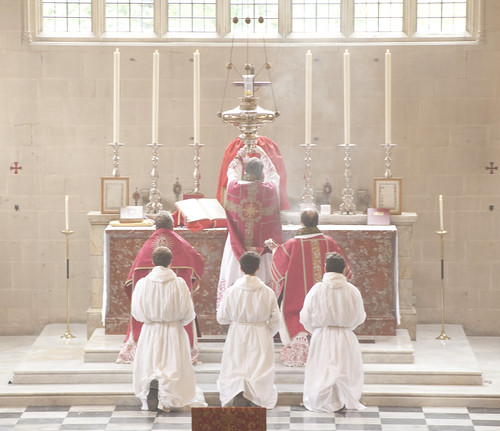
As Mass progresses, the incense increasingly clouds my photos of the sanctuary, taken from the choir loft.
Support the work of the LMS by becoming an 'Anniversary Supporter'.
Novel: The Devil Hates Latin
 I've just read a new novel, a first novel, with a Catholic theme: 'The Devil Hates Latin' by Katharine Galgano. It is being published by Regina Magazine. It is really more of a thriller than anything else, involving both the corruption and the graces which characterise the Church of today, and of all ages.
I've just read a new novel, a first novel, with a Catholic theme: 'The Devil Hates Latin' by Katharine Galgano. It is being published by Regina Magazine. It is really more of a thriller than anything else, involving both the corruption and the graces which characterise the Church of today, and of all ages.
You can buy it here (UK) and here (USA).
Something we need to try to keep hold of today is the interplay in the Church, and in the world as a whole, of really terrible bad things, and the action of God. I think Catholics can handle this better than Protestants, as long as we manage to escape the historically Protestant idea that the Church is or should be the community only of the saved. Of course the Church contains sinners, chancers, the ambitious and the corrupt, and some of these will attach themselves to positions of prestige in the Church because they like the idea of the prestige and the money and influence that it might bring. The Church also contains the lukewarm, and people who have made all sorts of compromises without ever saying to themselves that they no longer believe.
Into this endlessly complicated situation the Devil seeks to bring souls to Hell, and God works his grace, especially through the sacraments. It is a battle fought by all of us, day by day, Mass by Mass, confession by confession, temptation by temptation. Galgano presents this in a highly dramatised form, which is hugely fun to read, but also also says something fundamentally true about the fallen human condition, with some pithy insights into culture, politics, and the Church.
You can buy it here (UK) and here (USA).
Support the work of the LMS by becoming an 'Anniversary Supporter'.
New Book: 'Gradual' by Berkely and Scotland
| From the Moretus Gradual, 1598 |
I've just purchased a read an intriguing, short book on the restoration of rare, late-16th century printed Gradual: a collection of chants for the Church's liturgical year. The Gradual in question was beautifully printed in the Spanish Netherlands, using hand-copied monastic chant books as its sources.
The chant notation (shown, left) looks very like that used in the editions most singers use today, though it used five staves and lacks some of the specialised note-shapes (singers will note that there don't seem to be any quilismas or liquescents). Again, it (obviously) doesn't include the editorial marks added by the monks of Solesmes to most modern editions.
Although the melodies are somewhat different from the ones used today, which have been restored by reference to the oldest available manuscripts, they are quite different from the simplified and clunkily-printed chant used immediately before the Solesmes-influenced 1907 Graduale Romanum, upon which later editions have been based, exemplified by the 1870 Pustet edition shown below.
 |
| From the Pustet Graduale of 1870 |
The story of the restoration is fascinating, as it the discussion of the place the Gradual had in the
Counter Reformation programme of restoration in the Spanish Netherlands.
The book, Gradual by Julian Berkely and Tony Scotland, is available, with a pre-publication discount, at £13 from Shelf Lives (inc UK p & p) up to Mon 15th May; thereafter it will be bookshops, including John Sandoe in London, at £15, or from Amazon at £16 (inc UK p & p).
 |
| From the 1961 Graduale Romanum |
The book's blurb:
An illustrated monograph about the rescue, restoration and history of a monumental book of early printed Gregorian Chant, and its continuing use in the revival of the traditional Latin liturgy. The Gradual of the title, containing the chants of the Mass, was published by the great Renaissance printer, Jan Moretus, at the Plantin Press in Antwerp in 1598. This was the supreme achievement of a new technology supplanting the art of illuminated manuscripts – and an act of defiance by a Church besieged by the Protestant forces of the Reformation.  While the Dutch War of Independence raged around Antwerp, the Plantin Press spared no expense in creating this important and infl uential work, sending copies throughout the Catholic world to keep the Divine Office alive, and to raise the spirits of the recusant faithful. Among these were the aristocratic English women who fled Elizabeth’s persecutions for the relative safety of the Spanish Netherlands, and founded a Benedictine convent in Brussels, under the abbacy of Dame Joanna Berkeley. The ancient Chants which the Brussels Dames sang from their Moretus Gradual more than four hundred years ago had already survived a millennium – and are drawing a new generation of young people today.
While the Dutch War of Independence raged around Antwerp, the Plantin Press spared no expense in creating this important and infl uential work, sending copies throughout the Catholic world to keep the Divine Office alive, and to raise the spirits of the recusant faithful. Among these were the aristocratic English women who fled Elizabeth’s persecutions for the relative safety of the Spanish Netherlands, and founded a Benedictine convent in Brussels, under the abbacy of Dame Joanna Berkeley. The ancient Chants which the Brussels Dames sang from their Moretus Gradual more than four hundred years ago had already survived a millennium – and are drawing a new generation of young people today.
Support the work of the LMS by becoming an 'Anniversary Supporter'.
Colloquium on Limbo in Ramsgate, 30th June-1st July
 |
| Dante visiting the First Circle of Hell: limbo, where the souls of good pagans, like the ancient philosophers, enjoy a state of peace and natural happiness. |
DR LAWRENCE FEINGOLD; FR ANDREW PINSENT; DR JOHN A. DEMETRACOPOULOS; FR JOHANNES MARIA SCHWARZ; DR ALYSSA PITSTICK
Theme:
The doctrine of Limbo has been a subject of controversy for nearly seventy years. What is the state of those who depart this life with original sin only? Is it possible to maintain that no souls do depart this life in such a way? Intimately tied to the question of the 'natural desire for God' and to the dispute over the necessity of faith in Christ for salvation, Limbo occupies a strategically vital position in the theological landscape.
New on the Order of Malta
 |
| Image h-t Andrew Cusack |
The election of a new Grand Master of the Order of Malta in Rome on Saturday - tomorrow - has precipitated an avalanche of news stories, many containing intriguing claims about the root causes of the shock resignation of the last Grand Master, Fra Matthew Festing.
The most interesting aspect, which has been revealed already in part by past postings by Steve Skojek at One Peter Five, is the role of money in the saga of the Knights. The claim is that because Order was a beneficiary of a shadowy trust based in Switzerland, the attempts by Fra Matthew Festing to get to the bottom of this trust and ensure that the law was followed threatened to precipitate revelations which would be embarassing to people in positions of considerable influence in the Vatican. Festing had to be removed in order to remove this threat. The interim leadership of the Order has, at any rate, rapidly come to an amicable agreement with the trustees of this trust and we may now hear no more about it.
Pope Francis' alleged role in this reminds me very much of the role of Pope Benedict and Pope John Paul II in various Vatican scandals: that of trying to keep a lid on a situation which he cannot ultimately control. Pope Benedict was, frankly, defeated by the problems at the Vatican bank, and Pope John Paul by the clerical abuse problem. I don't think any of these popes were personally implicated in wrongdoing. What none of them allowed, however, was a big melt-down involving the public disgrace of senior officials and the publication of a lot of embarassing information. Such a thing is almost unthinkable in the Vatican, but it may in fact be the only thing which would actually resolve the problem,
Here is a selection of news stories:
One Peter Five: Fr Matthew Festing has decided to go to Rome for the election despites attempts to stop him
Church Militant: several strands about the current situation and its causes
Lifesite News: members of the Order petition Pope Francis for an explanation of his unprecedented intervention in the Order
Edward Pentin in Catholic Register: Vatican allows Festing to attend the election after all
Mass in a bottle
This is so wonderful that I want to share it. From Twitter, hat-tip to Dr Francis Young (website):
@SuffolkRecusant
I don't, unfortunately, have any other information about this image.
Support the work of the LMS by becoming an 'Anniversary Supporter'.
Dominican High Mass this Saturday in Oxford
Support the work of the LMS by becoming an 'Anniversary Supporter'.
York Pilgrimage: Sat 29th April
Support the work of the LMS by becoming an 'Anniversary Supporter'.
Hamish Fraser on making the Faith visible
 |
| A passer-by taking a photo of the procession with the Easter Candle at the Easter Vigil in St Mary Moorfields. |
I've been reading Hamish Fraser's Fatal Star, part biography and part commentary on the Church of his day. It was published in 1952, Fraser having been received into the Church some seven years earlier, after an extended period as a Communist activist: including in the Communist secret police in the Spanish Civil War. The edition I have includes extracts from his writings up to the 1980s.
Fraser became a greater supporter of the Traditional Mass, but this isn't the focus of this book. Instead, he connects the Presbyterian culture of his childhood with the untrammelled capitalism which made Communism attractive, laments the failure of the Church to offer an alternative, and points to the message of Fatima as a call to do just this, not (simply) through private devotions, but through penance and conversion of life. He quotes Sister Lucy as saying that the primary message of Fatima is not the Rosary or the First Saturdays, but Penance, and the duties of one's state of life.
His experience of Catholics in industrial Glasgow between the wars was that they offered a watered-down Marxism as a response to the social ills of the Great Depression. After the Second Vatican Council, this was even more the case, and in the case of Liberation Theology, not much watering down was being done. In the meantime, Fraser had discovered the Church's social teaching (Leo XIII and his successors), when researching for a prize essay, and was bowled over by it. He thought it would be fun to win a prize essay on the subject of religion as an atheist, but was no longer an atheist by the time he received it. God has a sense of humour.
Why, he asks, was no one in the Church talking about this social teaching? Or so few that it never percolated down to ordinary Catholics in the trade union movement. Leo XIII framed his teaching precisely as a counter to the rise of anti-clerical Socialism, but it was simply never incorporated into the Church's everyday teaching and practice.
There is a good deal to be said about this historical question, but it also raises a broader practical question for today. People are not going to benefit from what Christ has given the Church to help them be saved if they do not hear anything, or anything positive, about the Church. Most people do not hear Catholics talk about the Faith, and they do not see the Faith manifested in any other way either.
One would never know, from Fraser's complaints about the Church of the 1930s and 1940s, that this was a high point of Catholic evangelisation. It doesn't mean he was wrong: perhaps the Church could and should have been doing even better. But compared to today the Church was visible. Catholic colleagues at work could be identified in all sorts of ways, such as their eating fish on Fridays, which would be impossible today. They were not just identifiable as Catholics by such symbolic actions, however, they had noticeably different attitudes. In the society depicted by the novels of Graham Greene, Evelyn Waugh, and others of that generation, being a Catholic meant that you'd have noticeably different attitudes to a range of ethical issues, including sex outside marriage, abortion, and euthanasia. It wasn't that Catholics were all saints, but their Faith made a difference to way they thought even if they were sinners.
To manifest one's religion in this kind of way today is to set oneself apart not only from non-Catholic society, but from the majority of one's fellow Catholics. Most self-identified Catholics do not attend Mass, nor do they have particularly strong or distinctive views about divorce or contraception. Fraser thought that the Faith was invisible in 1950; today you need a microscope to detect it. When an individual Catholic does do or say something reflective of the Faith, far from being representative of the Catholic community, it is nominal Catholics who will be among those most eager to shout him down. Outsiders don't always have any reason to think that an orthodox Catholic is more characteristic of the Faith than an unorthodox one. Converting to the Faith must seem a little like joining a debating society, perhaps with a view to supporting the less popular side.
It is not easy to know how to handle this situation. What I would at least suggest is that we still need, indeed need more than ever, Catholics in the workplace, in academia, and in the media, who are identifiable as such; we need all kinds of good works to be identifiable as Catholic; and we need ideas identifiable as Catholic in debates about all manner of public and private matters.
Perhaps this is obvious, but there are many who do not behave as though it were true. While I criticise no one who needs to keep the Faith under the radar for personal reasons in the workplace--only they can make that judgement--others make a virtue of it, claiming that they can do more good by being invisible. I'm sorry, but this is wrong. You may have some good influence, but if you succeed in hiding the fact that this influence has any connection with the Catholic Faith, you have also done harm, by creating the dangerous illusion that the wholesome moral instincts and the energy to implement them can as easily spring out of a purely secular source as from grace.
Again, many Catholics can't see a Catholic organisation doing some good work or other without wanting to make it more 'inclusive', either of other Faiths, or of secularists, making it either officially ecumenical or Catholic only in its 'heritage'. Again, this is a way of pretending that good works springing from a living Faith are just humanistic impulses. It is not evangelisation, but a counter-evangelisation.
I don't see the situation for evangelisation in this country as entirely hopeless. If you know where to look, you can find a great many Catholics, deeply indebted to the Faith, serving their fellow citizens in all sorts of ways, which should be making the Faith visible. There is a problem, however, that so many of them are deliberatly trying to keep their Faith under wraps.
To repeat, I don't blame anyone for keeping quiet when colleagues mention the explosive issues of the day, in order to preserve the ability to earn a living for their family. What I am blaming is the attitude that a self-confessedly Catholic organisation, initiative, or idea is ipso facto an embarrassment. If you are embarrassed of Christ, ultimately, he will be embarrassed of you.
For he that shall be ashamed of me, and of my words, in this adulterous and sinful generation: the Son of man also will be ashamed of him, when he shall come in the glory of his Father with the holy angels. (Mark 8:38)
Support the work of the LMS by becoming an 'Anniversary Supporter'.


